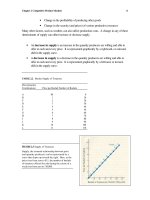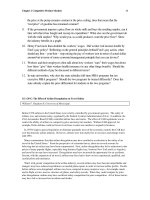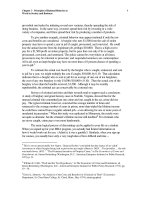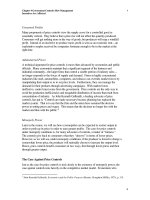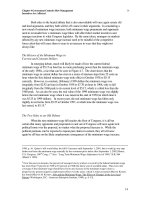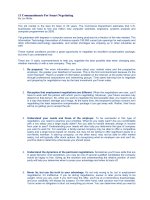Tài liệu Design for Sustainability a practical approach for Developing Economies doc
Bạn đang xem bản rút gọn của tài liệu. Xem và tải ngay bản đầy đủ của tài liệu tại đây (6.21 MB, 128 trang )
Design for Sustainability
a practical approach
for Developing Economies
Design for Sustainability
a practical approach
for Developing Economies
UUnniitteedd NNaattiioonnss EEnnvviirroonnmmeenntt PPrrooggrraammmmee
DDiivviissiioonn ooff TTeecchhnnoollooggyy,, IInndduussttrryy aanndd EEccoonnoommiiccss
39-43 Quai André Citroën
73739 Paris
CEDEX 15, France
Tel: +33 1 44371450
Fax: +33 1 44371474
E-mail:
Internet: www.uneptie.fr/pc
DDeellfftt UUnni
ivveerrssiittyy ooff TTeecchhnnoollooggyy
FFaaccuullttyy ooff IInndduussttrriiaall DDeessiiggnn EEnnggiinneeeerriinngg
DDeessiiggnn ffoorr SSuussttaaiinnaabbiilliittyy PPrrooggrraammmmee
Landbergstraat 15
2628 CE Delft
The Netherlands
Tel: +31 15 278 2738
Fax: +31 15 278 2956
E-mail:
Internet: www.io.tudelft.nl/research/dfs
With financial support from
IInnWWEEnntt IInntteerrnnaattiioonnaallee WWeeiitteerrbbiilldduunngg uunndd EEnnttwwiicckklluunngg
gGmbH
Capacity Building International, Germany
Friedrich-Ebert-Allee 40
53113 Bonn
Germany
Tel: +49 (0) 228 - 44 60 1106
Fax: +49 (0) 228 - 44 60 1480
Internet: www.inwent.org
On behalf of the
FFeeddeerraall MMiinniissttrryy ffoorr EEccoonnoommiicc
CCooooppeerraattiioonn aanndd DDeevveellooppmmeenntt,,
Germany
Acknowledgements
SSuuppeerrvviissiioonn,, tteecchhnniiccaall eeddiittiinngg aanndd ssuuppppoorrtt
Ms. Garrette Clark, UNEP DTIE, France
AAuutthhoorrss
Dr. M.R.M. Crul and Mr. J.C. Diehl
Delft University of Technology,The Netherlands
Faculty of Industrial Design Engineering
IInntteerrnnaattiioonnaall SScciieennttiiffiicc aanndd PPrrooffeessssiioonnaall RReevviieeww PPaanneell
Mr. Smail Al-Hilali, MCPC, Morocco
Prof. Dr. Han Brezet, Delft University of Technology, The Netherlands
Prof. Dr.Tijani Bounahmidi, LASPI, Morocco
Mr. Lelisa Daba, NCPC, Ethiopia
Mr. Bas de Leeuw, UNEP DTIE, France
Prof. Dr. Patrik Eagan, University of Wisconsin-Madison, United States of America
Mr. Juan Carlos Espinosa, Universidad Los Andes, Colombia
Mr. Leonardo Guiruta, MNCPC, Mozambique
Mr. Jens Hönerhoff, CEGESTI, Costa Rica
Mr. Evert Kok, UNIDO,Austria
Mr. Samantha Kumarasena, NCPC, Sri Lanka
Mr. Nguyen Hong Long, NCPC,Vietnam
Ms. Sophie Loran, UNEP DTIE, France
Dr. Diego Masera, UNEP Regional Office for Latin America and the Carribbean, Mexico
Dr. Desta Mebratu, UNEP Regional Office for Africa, Kenya
Mr. Zhao Ming,Tsinghua University Beijing, China
Mr. Sergio Musmanni, CNPML, Costa Rica
Dr. Kasimoni Patrick Mwesigye, UCPC, Uganda
Ms. Maria Amalia Porta, CGPML, Guatemala
Mr. Peter Repinski, UNEP Regional Office of North America, United States of America
Mr. Alex Saer Saker, ODES, Colombia
Dr. Nurelegne Tefera,Addis Abbaba University, Ethiopia
Mr. B.S. Samarasiri, Moratuwa University, Sri Lanka
Prof. Dr. John Turyagyanda, Makerere University, Uganda
Dr. Sonia Valdivia, UNEP DTIE, France
DDeessiiggnn aanndd llaayy oouutt
Ms. Ana Mestre and Ms. Graça Campelo, SUSDESIGN, Portugal
PPhhoottooggrraapphhyy
Mrs. Carmen van der Vecht,The Netherlands and SUSDESIGN Portugal
FFiinnaanncciiaall ssuuppppoorrtt
InWEnt - Capacity Building International, Germany
It is clear that current patterns of consumption and production are unsustainable.
The accelerating processes of globalization and trade liberalization, supported by
advances in information technologies, have fundamentally changed the landscape of
the private sector in all countries -developed and developing- providing new oppor-
tunities and challenges. Companies, large and small, have made impressive efforts to
address sustainability issues with a triple bottom line focus. Design for Sustainability
(D4S) has the potential to improve efficiencies, product quality and market oppor-
tunities (local and export) and at the same time improve environmental performance.
In many developed countries, because of a high level of awareness, D4S efforts are
linked to the broader concepts of product-service mixes, systems innovation and
other life cycle-based efforts. In developing economies, due to limited awareness,more
immediate technical support is needed to introduce the D4S concept. However,
successful implementation of D4S requires working in partnership. This publication is
an example of one such effort.
The growing attention paid to D4S is a natural outcome of UNEP’s work on
cleaner production, eco-efficient industrial systems and life cycle management. It is
the next step in a progressive widening of the horizon of pollution prevention; a
widening which has gone from a limited focus on production processes (cleaner
production), to include products (ecodesign), product-systems (D4S incorporating
transport logistics, end-of-life collection and component reuse or materials recy-
cling) and systems innovation.
Building upon the work carried out with the Dutch Delft University of
Technology and other experts in ecodesign, UNEP published the ground breaking
manual ‘Ecodesign:A Promising Approach to Sustainable Production and Consump-
tion” in 1997. The concept of product re-design has since then spread as seen in the
number of manuals and sector specific supporting materials now produced in many
languages. As a result and based on experience gained, ecodesign has evolved
through Design for Environment (DfE) to the broader concept of D4S – which
encompasses issues such the social component of sustainability and the need to
develop new ways to meet consumer needs in a less resource intensive way.
D4S goes beyond how to make a ‘green’ product – and now strives to meet con-
sumer needs through sustainability in a systematic and systemic way.
UNEP’s activities in the D4S area include the development of an updated global
manual for designers and other professionals working in the area of product develop-
ment in industry and elsewhere to provide support and guidance on the evolved
concept of D4S. It is useful to those new to ecodesign as well as those interes-
ted in breakthrough innovation for sustainability.
This practical approach for developing economies is based on the larger Design
for Sustainability: A Global Guide but focuses on the specific needs of small- and
medium-sized companies in developing economies. With all the progress in D4S,
few targeted efforts have been made to introduce the benefits of D4S to business
and business intermediaries in developing economies. Surveys of centres of excel-
lence confirm that D4S is a service that they could sell to industry. Increasing focus
of supply chain management efforts on resource use improvements reinforces this need.
Whereas, in developed countries end-of-life regulations provide incentives for com-
Foreword
panies to rethink what and how they are designing products, in developing economies
products tend to be ‘benchmarked’ (copied) from those existing on the market.
Companies are concerned about entering developed country markets. They need
to take into account new market standards to have access. In general, there is also
an overall lack of awareness in companies on how to improve efficiencies and im-
prove environmental performance at the same time.
Developing economies have different and more immediate needs. Awareness
about the implications of resource use – efficiency or environmental - is relatively
low. Reaching companies in developing economies can best be done through inter-
mediaries such as centres of excellence (UNIDO-UNEP National Cleaner Produc-
tion Centres, for example) or through supply chain relations with larger companies
including multi-nationals. Concerns for poverty alleviation and rapid environmental
degradation underscore the potential in developing economies for integrating D4S
into business development. D4S is one approach that enables ‘leap frogging’ over the
resource intensive and pollution generating development patterns that have been
followed by developed countries. UNEP, whose mandate is to work globally on envi-
ronmental protection and poverty reduction, especially in developing economies, is
one of the key international actors involved in developing this approach.
A draft version of the D4S approach was tested and modified based on the
results of a training session sponsored by InWEnt in October 2005, on representa-
tives from 9 countries. The publication introduces the D4S concept and outlines
how to apply it in a company setting. It can be used by companies to pursue internal
D4S efforts (via the supply chain or single operation context) and by intermediaries
who work with companies. The initial dissemination of the D4S concept will be
through the UNIDO-UNEP NCPCs, which operate as capacity building focal points
in some 30 countries.To further adapt the training materials, relevant examples and
case studies will be developed based on demonstration projects being carried out
in Costa Rica and Morocco in 2006. The lessons learned from the projects will be
integrated into the Spanish and French versions of the manual which will be availa-
ble on UNEP’s web site in 2007.
UNEP invites partners - companies, industry associations, governmental bodies,
educators- to join in collaboration by using the material in their own training pro-
grams and developing additional sector/product specific guides on how to plan for
and develop more sustainable products and services. In particular, we also welcome
case studies of lessons learned and feedback on how to best apply the D4S con-
cept in a practical setting.
Changing current unsustainable consumption and production patterns can bene-
fit a lot from the D4S approach. We envision that, as a result of the joint efforts of
all concerned partners, this publication will contribute to reversing the current ne-
gative trends.
Monique Barbut
Director
UNEP DTIE
D4S Graphic Design Concept
The D4S graphic design of this publication is based on the sustainability concept and its considera-
tion of the three elements of PEOPLE, PROFIT AND PLANET. The graphic design is comprised of
3 subjects and 3 colours to illustrate these elements:
PEOPLE are illustrated by the expressions of Human beings from different cultures and races.
PLANET is represented by different natural elements of the planet such as water, rocks, trees, sand
and plants.
PROFIT is illustrated by views of the building environment taken from examples of highly deve-
loped sites from throughout the world.
The graphic design was developed by SUSDESIGN, an entity devoted to the promotion of Design
for Sustainability and is illustrated with photographs of Carmen van der Vecht and SUSDESIGN.
Lgo Sto Antoninho, 3
1200 406 Lisboa
Portugal
Tel l Fax: + 351 213 422 200
www.susdesign.org
Photos by:
Carmen van der Vecht
www.streetarts.info
and SUSDESIGN
1> Introduction
1.1 _ The relevance of Design for
Sustainability (D4S)
1.2 _ To whom is this
publication addressed?
1.3 _ How is the
publication organized?
2> Design for Sustainability (D4S)
2.1 _ Products and Sustainability
2.2 _ Products and environmental aspects –
Planet implications
2.3 _ Life cycle and
improvement factor thinking
2.4 _ Products and social aspects –
People implications
2.5 _ Why should a company
look into D4S?
3> Product Innovation
3.1_ Innovation
3.2 _ Innovation levels
3.3 _ Product development process
3.4 _ Policy formulation
3.5 _ Idea generation
3.6 _ Realization
3.7 _ Product development in developing
economies
What is D4S
and why do it?
Part I
15
16
17
21
23
23
25
26
29
29
31
32
36
38
38
4> D4S Needs Assessment
4.1_ Level 1:The project
4.2_ Level 2:The national economic situation
4.3_ Level 3: Sector
4.4_ Level 4: Company
4.5_ D4S needs assessment action plan
5> D4S Redesign
Step 1_ Creating the team
and planning the project
Step 2_ SWOT, drivers
and goals for the company
Step 3_ Product selection
Step 4_ D4S drivers
for the selected product
Step 5_ D4S impact assessment
Step 6_ Developing a D4S
strategy and a D4S design brief
Step 7_ Idea generation and selection
Step 8_ Concept development
Step 9_ Evaluation of D4S
achievements
Step 10_ Implementation and follow-up
6> D4S Benchmarking
6.1_ Introduction to D4S Benchmarking
6.2_ Benefits of D4S Benchmarking
6.3_ D4S Benchmarking in practice
6.4_ How to carry out a D4S
Benchmarking project?
6.5_ Step-by-step D4S Benchmarking
6.6_ D4S Benchmarking for specific
product groups
How to do D4S
in practice
Part II
46
46
53
54
55
59
60
62
62
63
66
68
70
71
71
73
74
74
75
75
80
7> D4S Case studies in
Developing Economies
7.1_ Building the D4S team at
Fabrica Venus, Guatemala
7.2_ SWOT, Impact analysis and D4S
Strategies at Talleres REA, Guatemala
7.3_ Production Chain project at
Hacienda El Jobo, El Salvador
7.4_ Social aspects of sustainability:
construction products from
mining waste in South Africa
7.5_ New products and reuse:
Ragbag in India and The Netherlands
7.6_ Product redesign: a plastic bottle
at Microplast, Costa Rica
7.7_ Product redesign: MAKSS Packaging
Industries Ltd. in Kampala, Uganda
7.8_ Product innovation: a solar lantern
for the Cambodian market
7.9_ Product redesign: tailer for rural transport
of crops in Ghana
7.10_ Benchmark for refrigerator
of Waiman Industries, Costa Rica
7.11_ Benchmark: Intermech
cassava grater,Tanzania
7.12_ Benchmark: Philips
computer monitor
7.13_ An example of an internationally
supported D4S programme: InWEnt
8> D4S Rules of Thumb
9> Creativity Techniques
Further reading
Reference information
on D4S
Part III
87
88
90
91
93
94
96
97
98
100
101
103
104
107
113
121
What is D4s and why do it
duct innovation expert in their management team.
In developing economies the importance of product
innovation is rapidly increasing as well. In India, for
example, product innovation has become an important
discipline, especially after the Indian market opened to
international competition.
Small- and medium-sized industries (SMEs) will need
to focus on product development as well. In addition to
in-house product development expertise, this can be
done by cooperating with sector organisations, or
bringing in external experts from consultancies, univer-
sities and other expertise centres.
Products and Sustainability
Growing global concerns about environmental prob-
lems such as climate change, pollution and biodiversity
loss and about social problems related to poverty,
health, working circumstances, safety and inequity, have
fostered sustainability approaches for industry. In the
international policy arena, as illustrated by the World
Summit for Sustainable Development, governments,
industry and civil society have adopted the term sus-
tainable consumption and production.
Improved product design which applies sustainability
criteria - Design for Sustainability (D4S) - is one of the
most useful instruments available to enterprises and
IInnttrroodduuccttiioonn
Welcome to the joint UNEP and Delft University of Technology publication on
Design for Sustainability: a practical approach for developing economies! In
this introduction, the relevance of D4S for developing economies is highlighted.
Next, the target groups of this publication are defined, and the overall struc-
ture of the publication is explained.
000011
1.1 The relevance of
Design for
Sustainability (D4S)
Product Innovation
Companies all over the world increasingly need to inno-
vate their products and processes to: keep up with
competitive pressure; increase productivity within the
region or worldwide; defend or expand market share;
and to create the ability to attract foreign investments.
However, companies in developing economies can be
left out of this cycle for a variety of economic and struc-
tural reasons.
Product innovation is becoming one of the key strate-
gic options available to firms, supply chains and integrated
industrial sectors in developing economies to compete
better in today’s global market. Through advances in
information, communication and infrastructure, local and
international markets are becoming more competitive and
challenging - obliging companies to adapt.
The interest in product innovation has grown rapidly
during the past decades. Industrialisation, open markets,
higher (quality) requirements from customers and an
increase in competitiveness between companies locally
and globally have created a serious demand for a struc-
tured process for product innovation within industry.
Industries cannot survive in the long-run without product
innovation as an integral part of the company manage-
ment and product development processes. International
industries have reacted to these developments by creating
their own product innovation departments or by con-
sulting with external product innovation experts.Many
core, is the development of a new global guide for
designers and industry providing support and guidance
on the evolved concept of D4S (Design for
Sustainability: A Global Guide, UNEP 2006). It is use-
ful to those new to ecodesign as well as those interes-
ted in breakthrough innovation for sustainability. The
guide is the result of the long-term cooperation of
international D4S experts from the Netherlands,
Sweden, Italy, France, Germany, Japan and Austra-
lia, UNIDO, the Swedish EPA and InWEnt, Germany
and reflects the evolution of the concept since the ini-
tial guide was produced in 1997.
However, many sector- and country-specific issues
still need to be addressed. In developing economies
products tend to be ‘benchmarked’ (copied) from those
existing on the market. Companies are concerned
about developed country markets. They need to take
into account standards of developed country markets
to gain access. In general, there is an overall lack of awa-
reness in companies on how to improve efficiencies and
improve environmental performance at the same time.
As a result, UNEP sponsored the development of this
publication that provides a simple step-by-step metho-
dology that focuses on the needs of small- and medium-
sized enterprises (SMEs) specifically in developing
economies. UNEP invites partners - companies, industry
associations, governmental bodies,and educators - to join
and collaborate in developing additional sector and/or
product-specific packages to promote D4S more widely.
The DfS Programme of the Delft University of
Technology in The Netherlands has extensive experi-
ence in sustainable product innovation in developing
economies. Several product innovation programmes
have been carried out in Africa,Asia and Latin America
over the last ten years, and new projects are started
regularly. The projects are carried out in close coope-
ration with partners from local industries, transnational
companies, universities, governments and non-govern-
mental organisations. Several of the company projects
serve as case studies in this publication.
1.2 To whom is this publi-
cation addressed?
This publication has been written for intermediaries
that work with SMEs in developing economies, such as
governments to deal with these concerns. D4S includes
the more limited concept of Ecodesign or Design for
the Environment. In many developed economies D4S is
closely linked to wider concepts such as sustainable
product-service systems, systems innovations and other
life cycle based efforts. In developing economies a lack
of awareness remains a stumbling block.
A broad definition of D4S would be that industries
take environmental and social concerns as a key ele-
ment in their long-term product innovation strategy.
This implies that companies incorporate environmen-
tal and social factors into product development
throughout the life cycle of the product, throughout
the supply chain, and with respect to their socio-eco-
nomic surroundings (from the local community for a
small company, to the global market for a transnation-
al company (TNC)).
UNEP and Delft University of
Technology
This publication was drafted by the Design for
Sustainability (DfS) Programme of Delft University of
Technology for UNEP’s Production and Consumption
Unit of the Division of Technology, Industry and
Economics. Both organizations have been active in the
area of promoting more sustainable product design
since similar concepts were introduced in the 1990s.
Many organizations have developed tools and
approaches to help companies (and those who work
with companies) rethink how to design and produce
products to improve profits and competitiveness and to
reduce environmental impacts at the same time. In 1997
UNEP, in conjunction with Delft University of
Technology and other experts in Ecodesign, published
the ground-breaking manual “Ecodesign: A Promising
Approach to Sustainable Production and Consum-
ption.” The concept of product ecodesign has since then
spread as seen in the number of manuals and sector-
specific supporting materials that are available in many
languages. As a result, and based on experience, Eco-
design has evolved to encompass broader issues of the
social component of sustainability and the need to
develop new ways to meet consumer needs in a less
resources intensive way. D4S goes beyond how to make
a ‘green’ product and now embraces how best to meet
consumer needs more sustainably on a systematic level.
UNEP’s activities in the D4S area are varied. At the
16
centres of excellence (UNIDO-UNEP’s National
Cleaner Production Centres), business associations,
consultants or universities. Next to these intermedi-
aries, the publication can also be used by companies
that are partners in a product innovation project or
programme.The chapters on how to do D4S Redesign
and Benchmarking are specifically written to be used by
a project team of company representatives and inter-
mediaries to execute a product innovation project.
Ideally, the D4S approach can be used in a collabora-
tive process with several partners for whom this publi-
cation can serve as a reference methodology, and a
source of information and experience.
1.3 How is the publica-
tion organized?
This publication has three parts, and each part has three
chapters.
The first part, What is D4S and why do it?
(Chapters 1 to 3) describes the D4S concept in more
detail and what might motivate companies in developing
economies to adopt it. Chapter 2 provides an overview
of the relationship between sustainability and product
innovation, which lead to the concept of D4S.The rea-
sons and opportunities for SMEs in developing
economies are explained. For the companies involved in
a D4S project it may be the first time they have been
involved in a systematic product development process.
Therefore, Chapter 3 provides basic information on the
concept of product innovation, and explains the steps of
a product development process. The insights gained
from this part can assist companies and intermediaries
who work with companies in identifying the appropriate
approach to product development and sustainability.
The second part, How to do D4S in practice
(Chapters 4 to 6) is the backbone of this publication. It
explains three practical, step-by-step approaches to
execute a D4S project in a company. Chapter 4, the D4S
Needs Assessment shows how to evaluate the econo-
mic position of a country and how to prioritize indus-
try sectors in order to target the selection of demon-
stration project companies.This chapter is intended for
intermediaries who set up a D4S programme or pro-
ject. Chapter 5 outlines the step-by-step approach to
carry out a D4S Redesign project, aimed at the sustai-
nability-driven, incremental improvement of an existing
product. In Chapter 6, the D4S Benchmarking approach
is presented. In short, the approach is to use competi-
tors’ efforts to develop new products.This approach is
especially suitable for those companies that develop
products based upon imitating existing products. The
redesign and benchmarking approaches are comple-
mentary to each other and can be used in combination.
For each of the three practical approaches of Part II,
a set of accompanying worksheets is available on the
CD-ROM which is inserted at the back of this publica-
tion.All worksheets are referenced in the text.
In Part III, Reference information on D4S, additional
information is provided that can support the execution
of a D4S project. Chapter 7 provides the reader with
D4S case studies from developing economies. These
case studies are examples for specific phases and strate-
gies that are explained in Part II. Chapter 8 presents
‘rules of thumb’ for carrying out a D4S project. These
are basic suggestions to consider when identifying sus-
tainable product improvement options. Chapter 9 gives
an overview of creativity techniques that can be applied
by a D4S team during a project to come up with cre-
ative and novel solutions for product innovation issues.
Lastly, suggestions for further reading are given.
On several places in the text, reference is made to
other publications by citing the authors' name and the
year of publication.These and other references can be
found in the section 'Resources and further reading'
after Chapter 9 of the publication.
The publication is supported by additional materials
on the accompanying CD-ROM, including a printer-
friendly PDF file of the whole publication, which is also
available on the web at: www.d4s-de.org
An overview of the publication is in Figure 1.
17
PPuubblliiccaattiioonn OOvveerrvviieeww
Figure 1 ___ Publication overview
approaches to help companies (and those who work
with companies) rethink how to design and produce
products to improve profits and competitiveness and to
reduce environmental impacts at the same time. As a
result, and based on experience gained, Ecodesign evol-
ved to encompass broader issues such as the social
component of sustainability and the need to develop
new ways to meet consumer needs in a less resource
intensive way. D4S goes beyond how to make a ‘green’
product - the concept now embraces how best to meet
consumer needs – social, economic and environmental -
on a systematic level. These 3 key elements of sustaina-
bility are also referred to as people, planet and profit.
2.1 Products and
Sustainability
It is clear that current patterns of consumption and pro-
duction are unsustainable.The accelerating processes of
globalization and trade liberalization, supported by the
advances in information technologies, have fundamen-
tally changed the landscape of the private sector in all
economies - developed and developing - providing new
opportunities and challenges to improve sustainability.
Companies, large and small, have made impressive
efforts to address sustainability issues with a bottom
line focus.Through supply chain management, corporate
reporting, and adopting related international standards,
companies are improving the efficiency of current pro-
duction and the design of new products and services to
meet consumer needs.
These profit-driven strategies go by many names.
Sustainable product design, also known as Design for
Sustainability or D4S, including the more limited con-
cept of Ecodesign, is one globally recognised way
companies work to improve efficiencies, product
quality and market opportunities (local and export)
while simultaneously improving environmental per-
formance. In many developed economies, because of
a high level of awareness about the potential of effi-
ciency and environmental concerns, D4S efforts are
linked to wider concepts such as product-service
mixes, systems innovation and other life cycle-based
efforts. In developing economies, more immediate tech-
nical support is needed to introduce the D4S concept.
D4S is based upon the combination of product innovation and sustainability.
In this chapter the role of sustainability and its importance in product inno-
vation are explored.Three key elements of sustainability are planet, people
and profit.The relation of the first two - environmental and social aspects -
and product innovation is explained. The ‘profit’ aspect will be explained in
Chapter 3.The reasons and opportunities why a company should look into
D4S are detailed.
000022
Figure 2 ___ People, Profit, Planet and Product.
DDeessiiggnn ffoorr
SSuussttaaiinnaabbiilliittyy ((DD44SS))
They are linked to the element of product innovation
(see Figure 2).
Product innovation is directly linked to sustainability:
both are oriented towards change and the future.
Sustainability is concerned with the well-being of the
future. Product innovation is concerned with creating
new products and services that generate value only if
they fit in this future. In this chapter, the focus is on the
aspect of sustainability. In Chapter 3, the different pro-
duct innovation approaches are explored and the product
development process is explained.
To be sustainable, product innovation must meet a
number of challenges linked to people, planet and prof-
it: social expectations and an equitable distribution of
value along the global value chain, and the innovation
must work within the carrying capacity of the suppor-
ting ecosystems.
These challenges overlap and are distributed diffe-
rently over the economic spheres in the world.The dif-
ferences are large: the average American consumes 17
times more then his or her Mexican counterpart and
hundreds of times more than the average citizen of the
Congo. Examples of sustainability challenges include:
Create opportunities to meet social and equity
requirements (people):
A> Developed economies_
> Increase urban and minority employment
> Improve safety and well-being
> Acceptation and integration of minorities
> Reduce income inequity
B> Developing economies_
> Enhance number of skilled workers
> Reduce income inequity
> Improve working conditions
> Abolish child labour
> Reduce illiteracy
> Basic health services
> Clean drinking water
> Reduce population growth
> Improve status of women
> Abolish large scale dislocation of people
Fit within the carrying capacity of supporting
ecosystems (planet):
A> Developed economies_
> Reduce fossil energy use (climate change)
> Reduce use of toxics
> Clean contaminated sites
> Improve level of prevention, recycling, and reuse
B> Developing economies_
> Reduce industrial emissions
> Waste water treatment
> Stop overexploitation of renewable resources, water
> Stop deforestation, soil loss, erosion, ecosystem
destruction
> Reduce dung and wood burning
Create equitable value for customers and stake-
holders along the global value chain (profit):
A> Developed economies_
> Profitability
> Value for company, stakeholder
> Value for customer
> Fair business model
B> Developing economies_
> Fair share of and linkage to global value chains
> Linkage of SMEs to large and transnational companies
> Industrialisation of production, economies of scale
> Fair price for commodities and raw materials
> Ownership and credit opportunities for entrepreneurs
Many product innovation ideas would never be imple-
mented if they were required to meet all the above
criteria. Therefore, the goals and targeted elements of a
D4S project need to be clearly defined.
A carefully prepared D4S project can contribute pow-
erfully to a company’s future. A business that wants to
become and/or remain competitive will need to address
sustainability issues. Large companies, as well as custo-
mers, governments and international organisations, are
increasingly building sustainability requirements into their
supply chains. Investment in a sustainable product innova-
tion strategy can have immediate and longterm benefits.
22
During the development of a new product, or the
redesign of an existing one, the product development
team is confronted with a variety of design criteria
like quality, ergonomics, safety, aesthetics etc. With
the D4S approach, environmental and social criteria
are integrated into the product development process
as well, minimizing the impacts of the product through-
out its life cycle.
2.2 Products and
environmental aspects –
planet implications
In the late 1980s and early 1990s, sustainability largely
was an environmental issue. Initially efforts focused on
improving end-of-pipe technologies. The focus then
shifted towards production improvements via concepts
such as clean technology, cleaner production, and eco-
efficiency. The next shift was to product impacts, there-
by taking into account the whole product life cycle.
Concepts like Ecodesign and Design for the Environ-
ment (DfE) were developed and put into practice.
Environmental impacts can be divided into three
main categories: ecological damage, human health dam-
age and resource depletion (see Table 1). Many of these
types of impacts are relevant for SMEs in developing
economies, such as eutrophication, land use, ecotoxici-
ty, human health damage, and the depletion of fossil
fuels and fresh water.
Another way to classify the different types of envi-
ronmental impacts is to arrange them according to
geographical scale levels – local, regional, fluvial, con-
tinental and global.Typically, the higher the scale level,
the more sources that contribute to the impact and
the longer it will take for the improvements to
become visible – depending of course on the rever-
sibility of the problem. Local problems like water
pollution, soil pollution, and waste disposal have been
dealt with successfully in industrialised countries.
Global issues like climate change can only be tackled
by agreement of the best solutions at the global level.
Irreversible depletion problems, even when occurring
locally (topsoil), cannot be easily solved.
23
Table 1 ___ Ecological Impact Categories.
2.3 Life cycle and
improvement factor
thinking
The D4S approach is based on taking a life cycle view of
a product.The product life cycle starts with the extrac-
tion, processing and supply of the raw materials and
energy needed for the product. It then covers the pro-
duction of the product, its distribution, use (and possi-
bly reuse and recycling), and its ultimate disposal.
Environmental impacts of all kinds occur in different
phases of the product life cycle and should be accoun-
ted for in an integrated way. Key factors are the con-
sumption of input materials (water, non-renewable
resources, energy in each of the life cycle stages) and
production of output materials (waste, water, heat,
emissions, and waste) and factors like noise, vibration,
radiation, and electromagnetic fields.
Example: Life
cycle of a shirt
Shirts are often a com-
bination of natural and
synthetic fibers. To pro-
duce natural fibers (e.g.,
cotton), energy, fertiliz-
ers, water and pesti-
cides are needed. For
the synthetic fibers, fos-
sil fuels are needed. In the next step, fibers are
combined into cloth or textile. During this
process, water, energy and chemicals are used to
give cloth its colour and other characteristics.
From the cloth,shirts are being produced that are
then packaged and distributed to retail shops.
After the consumer has purchased the shirt, he
or she will discard the packaging and will use the
shirt. During the use phase, the shirt might be
used about 100 times and washed, dried and
maybe even ironed. Each of these steps has envi-
ronmental impacts resulting from detergent,
water and energy use. Finally, perhaps when some
parts of the shirt have worn out, it will be dis-
posed. It is not possible to compost it because of
the synthetic parts, and it may not be easy to
recycle because of the mixed materials. During its
life time, components of the shirt may have tra-
veled thousands of kilometers, since cloth pro-
duction could have been in Asia,the production in
North Africa and the retail in Europe.
TEXT BOX 1 ___ Life cycle Thinking
Raw material provision and factory production are
only two stages of the product life cycle. In many cases,
the distribution, use and disposal phases have higher en-
vironmental impacts than the production itself. The
environmental challenge for D4S is to design products
that minimize environmental impacts during the entire
product life cycle.
Sustainability also requires taking into account the
needs of future generations, meaning that current envi-
ronmental impacts should be reduced as well as those
impacts on future generations. Global environmental
pressures are directly related to the size of the popula-
tion which defines the level of consumption of each person,
and the materials and energy efficiency that produces
each ‘unit’ of consumption. Currently, it has been esti-
mated that environmental pressure should be reduced
by about half. Taking into account the growth rates of
developing economies, the efficiency of products and
processes would need to be improved by a factor of 4.
In a world with a population of 9 billion, and a consump-
tion level that is much higher than it is now, this would
imply materials and energy improvements by a factor of
10 to 20!
Figure 3: The Life Cycle of a product.
24
This type of ‘factor thinking’ shows the magnitude of
the task of reaching sustainability, and the critical need
to improve production processes, product, and systems.
For products, short-term incremental redesign of exis-
ting products can typically lead to improvements of a
factor of 2 to 4.To achieve the long-term factors of 10
to 20, radical product innovation is necessary (see
Chapter 3). This includes developing completely new
products, improving the product as well as the services
connected to it, and developing entirely new functional
systems of products and services. See Figure 4 which
illustrates the different degrees of environmental bene-
fit and degrees of innovation required.
This publication focuses on incremental innovation,
redesign and the benchmarking of existing products,
since these are the prevalent ways SMEs in developing
economies currently work. However, the need for more
radical product innovation will continue to grow. These
and other related approaches are presented in detail in
the publication Design for Sustainability: a Global Guide,
UNEP 2006.
2.4 Products and social
aspects – people impli-
cations
Social and societal aspects of sustainability have increa-
singly received attention in the last 10 years from the
media as exemplified by negative articles on issues of
child labour, companies running ‘sweatshops’, workers’
rights and on indigenous peoples. Company strategies
increasingly include corporate social responsibility in
addition to economic and environmental priorities.
25
A useful tool to visualise socio-economic and societal
aspects that are relevant to sustainability is presented in
Figure 5.
On the vertical axis the social aspects relevant to the
product supply chain are presented.The following issues
are relevant to all stakeholders:
> Human rights
The protection of the basic human rights of employees,
such as the right to lead a dignified life, the freedom to
express independent beliefs, and the absence of racial,
ethnic and gender discrimination.
> Minimisation of child labour
> Health and safety at the workplace/Human
Resource Management
The pro-active fostering of a high-quality work environ-
ment, workplace diversity, opportunities for vocational
education, and work-life balance for the employees.
> Governance and management
Setting in place systems and processes on accountabili-
ty for shareholders and government.
> Transparency and engagement of business
partners
The degree to which a company involves its business
partners in carrying out the company’s sustainability
strategy.
> Abolishing of corruption and bribery (see also:
Sustainability, 2005)
On the horizontal axis, the social aspects of the com-
pany in its local surroundings are expressed, from micro
(within the company itself) to meso-level (the communi-
ty within which the company exists) to macro-level (the
country within which the company exists, or for a trans-
national corporation, within the global environment.
> Local economic growth
The ways a company shares the benefits from its invest-
ments with local businesses or provide tools for eco-
nomic growth to local communities.
> Community development
Support of the company through provision of health,
education, water and sanitation, helping to fight corrup-
tion in the community and upholding indigenous and
human rights.
> Stakeholder engagement
Consulting with non-business stakeholders on key sus-
tainability issues: this could be in the form of open dia-
Figure 4 ___ Degrees of environmental benefit and of
innovation required.

